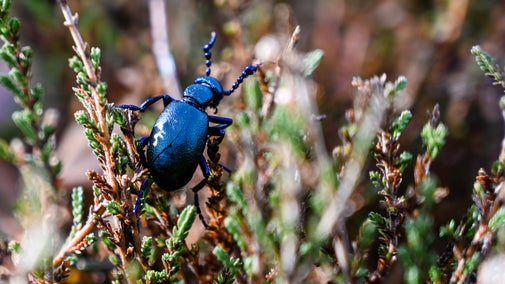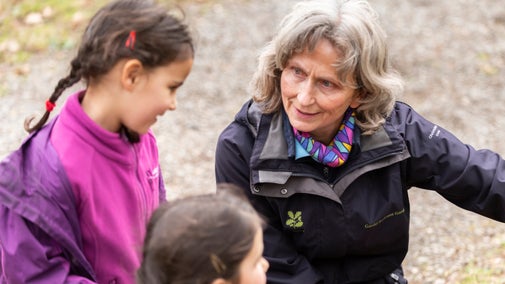
Donate
Everyone needs nature, now more than ever. Donate today and you could help people and nature to thrive at the places we care for.

Kinver Edge is home to a number of important habitats which need to be conserved. From looking after rare lowland heath to managing woodland for butterflies, discover some of the important work our ranger teams do on a regular basis.
Once widespread, heathland such as Kinver Edge is now an increasingly rare habitat in Europe. Important for reptiles, many birds, bats and moths, heathland has great ecological value. Our outdoors team work year-round to maintain this habitat.
The heathland of Kinver Edge is the product of years of human presence. Generations of people have grazed their animals here and used the trees for firewood and tools. This has created a patchwork of some open, sunny areas, places with shrubs such as heather and gorse, and areas with clumps of oak and silver birch trees - this is a varied heathland landscape. There are many rare plants and animals that need heathland to survive, and by keeping the landscape open and varied we help to protect them.
The best way to manage the heath sensitively is to graze it with cattle. We use a herd of English Longhorn cows, an ancient breed, who crush the bracken, chomp on bramble and nibble leaves and grass. Their trampling creates bare sandy areas that bees nest in and release heather seeds. By roaming around they naturally create a ‘mosaic’ of different habitats across the landscape, ideal for wildlife.
The heard wear GPS collars to enable farmers to draw virtual field boundaries using an app on their smartphone. The 'No Fencing' system allows the farmer to control and restrict the cows' access to areas of sensitive habitat. The collars detect and respond to the boundaries and alert the cows with a series of musical tones as they graze close to a virtual fence. If they persist, as a last resort, a small electric pulse dissuades them from leaving the grazing zone. Farmers can track each animal and always know where they are.
In areas where scrub and gorse start to dominate our team clear small patches each year from October to March, stopping in spring so as not to disturb nesting birds. Some of the felled wood is sold to raise money for our conservation work, some is used for events such as making bug hotels, and the rest is removed from the heath.

As well as protecting and improving the heathland we've got, we are also carrying out an ambitious restoration project on the former site of an aging conifer plantation at Blakeshall Common. We hope this newly cleared area may provide nesting opportunities for rarities such as nightjars that have been absent from Kinver Edge for many years and provide increased habitat for reptile species on site.
Sandscapes is a nature recovery project which aims to restore and reconnect areas of sandy habitats across the three counties of Shropshire, Staffordshire and Worcestershire. Heathland, once a widespread and common component of the landscape in the Midlands, is now isolated and fragmented. More than eighty percent of this rare and special habitat has been lost in the last 200 years, through agricultural change, conifer planting, development pressures and neglect. Wildlife that rely on this type of habitat, including many insects, reptiles and ground nesting birds, are endangered or under threat of extinction.

Another challenge for the team is controlling the invasive plant Himalayan Balsam. This non-native plant has found its way into the British countryside, where it quickly suppresses other flowers and reduces biodiversity.
We've been removing it from the heath by strimming it, mowing and pulling by hand throughout the spring and summer. There is even a dedicated team of local families who take their children out balsam bashing - they love ripping out the massive stems in the name of conservation!
Under the guidance of ecologists, we regularly monitor the current heathland, and restoration area to check the condition of the habitats, see what plants and animals are living here, to measure the success of our management plan.
We are already seeing the return of key plant species such as heather, heath bedstraw and wood sage to the newly restored heathland area. Wildlife such as the green tiger beetle, tree pipits, green hairstreak butterflies and common lizards that live in heathland have all been spotted in the restoration area too - a fantastic result for nature.
By felling trees at the edges of paths, we’ve opened up new habitats for nectar-rich plants to grow in and butterflies to travel up and down. These rides are an important habitat within a managed woodland, and at Kinver Edge we will be creating more of them over the coming years.
Rides are open, sunny corridors through the woodland, where we have removed taller trees to allow more light in, helping wildlife to flourish. At the edge of the path, short, small plants such as grasses, herbs and flowers grow which butterflies will thrive on. This vegetation gives way to shrubs like heather and bilberry, and then further from the path edge there are young trees that graduate into full woodland with taller, more mature trees and a shadier understory.
Woodland rides need regular management to stop the vegetation at the path edges reverting to full-sized trees. Every few years we fell trees at the path edges, leaving some standing as deadwood for insects and woodpeckers and giving the smaller plants room to flourish.

With your ongoing support, we're able to continue our vital conservation work. Thank you for helping to protect these special places.
By scraping back soil, we've been helping important pollinators to make their homes amongst the tiny grassland plants of Kinver Edge
The grassland at Kinver Edge is made up of lots of tiny, delicate plants. These plants love the acid, low-nutrient conditions here, and in spring and summer they bloom into a carpet of reds (sheep sorrel), pinks (common storksbill) and whites (birdsfoot pea). Thanks to the sandy soils there are lots of plants here that you normally find at the seaside, like sand spurrey, which is rare in the midlands.
There are also tiny holes in the sand – these are the homes of bees that tunnel down into the ground to make their nests. When it rains, the bees plug these holes up to keep the water out! Instead of living in a colony, these bees are solitary and the females raise their young alone.
In the past, farm waste has been dumped on these important wildlife spaces, giving brambles and nettles the nutrients they need to thrive and crowd out the special acid grassland plants. The ranger team are scraping back the top layer of earth to reveal the sandy ground below again, and creating miniature cliffs, facing south to allow the bees to enjoy the warmth of the sun. Visitors also help by trampling the grass, and even dogs get involved by digging fresh scrapes in the earth.

Everyone needs nature, now more than ever. Donate today and you could help people and nature to thrive at the places we care for.
The fragile heathland habitat at Kinver Edge is home to many rare species, with more familiar plants and animals also found in the surrounding woodland.

Read about the proposal for heathland restoration at Blakeshall Common, how the project will be delivered, and the public consultation on the proposal.
Find out about volunteering at Kinver Edge and the Rock Houses, and the current opportunities available.

Read about our strategy, which focuses on restoring nature, ending unequal access and inspiring more people.

We believe that nature, beauty and history are for everyone. That’s why we’re supporting wildlife, protecting historic sites and more. Find out about our work.
